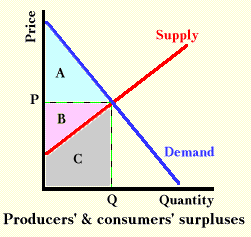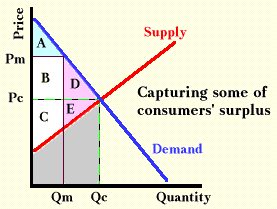Q.
Why are they called Consumer and Producer 'surplus'? What do you mean by 'surplus'? Illustrate how the graph can be used to explain market collusion among the producers.
A.
The producers' and consumers' surpluses are illustrated with supply and demand curves in the figure below. The total value to consumers of quantity Q is represented by areas A+B+C. Because the consumers must pay B+C, only the area A is surplus for them. [Why?
Because the consumers who were willing to buy at higher than Price 'P' are saving their surplus money as the price 'P' is lower than their prices. A is an area indicating that instead of much higher pricing, where the area under the line A in blue would have to be expended for purchasing the goods, now it is saved.]
Producers get revenue of B+C. B is their surplus because only payments of C are needed to attract the resources necessary to produce quantity Q. [Why?
For the supply curve indicates that at low prices, there are still some producers who are willing to produce. They would still produce area under the line C although at low price. However, they actually sold off their products at price 'P' which is higher than their intended price. This higher price means higher revenue, and after having deducted their original intended revenue C, they still left with B. And, therefore, this is a surplus for these producers.]


Alternatively, buyers can gang up on sellers and extract producers' surplus. They must restrict purchases to drive the price down. Again, this behavior is likely only when there are very few buyers and many sellers. When there is only one buyer, a monopsonist, economists expect it to restrict purchases.
What is good for the individual is not necessarily good for the group. Notice that the process of transferring the value of area Bfrom consumers to producers in the second graph above causes consumers to lose area D and producers to lose area E, and no one gets this lost value. D & E are called "Deadweight Loss".
In the process of increasing their surplus by seizing area B, producers cause the value of total surplus to shrink. There is a conflict here between the interests of producers and society as a whole. This loss of value, which is not offset elsewhere in the system, is the essence of the economist's case against monopoly.
However, if government impose a ceiling price onto the market, this is like buyers gang up to demand a cheaper price. Consumer would save more, hence increase in consumers' surplus at the expense of producers' surplus. The diagram below shows it Deadweight Loss as a result of producing less because the producers do not want to produce bigger quantity as price is unfavorable. The would be consumers who otherwise would had the goods, but now do without it due to scarcity. This is like special government funded mammograms, cheaper but not everybody gets it!
Ref:
http://ingrimayne.com/econ/MaximizingBeha/PandCSurplusIllust.html
[Own account]
